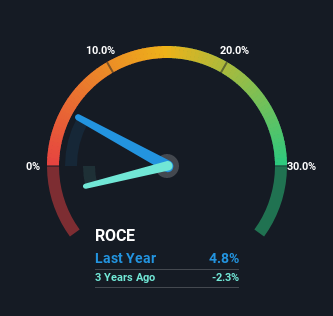- Poland
- /
- Specialty Stores
- /
- WSE:KOM
Komputronik's (WSE:KOM) Returns On Capital Not Reflecting Well On The Business

If you're looking for a multi-bagger, there's a few things to keep an eye out for. Ideally, a business will show two trends; firstly a growing return on capital employed (ROCE) and secondly, an increasing amount of capital employed. If you see this, it typically means it's a company with a great business model and plenty of profitable reinvestment opportunities. Although, when we looked at Komputronik (WSE:KOM), it didn't seem to tick all of these boxes.
Return On Capital Employed (ROCE): What Is It?
For those that aren't sure what ROCE is, it measures the amount of pre-tax profits a company can generate from the capital employed in its business. To calculate this metric for Komputronik, this is the formula:
Return on Capital Employed = Earnings Before Interest and Tax (EBIT) ÷ (Total Assets - Current Liabilities)
0.048 = zł18m ÷ (zł503m - zł131m) (Based on the trailing twelve months to December 2022).
Thus, Komputronik has an ROCE of 4.8%. In absolute terms, that's a low return and it also under-performs the Specialty Retail industry average of 23%.
View our latest analysis for Komputronik

While the past is not representative of the future, it can be helpful to know how a company has performed historically, which is why we have this chart above. If you want to delve into the historical earnings, revenue and cash flow of Komputronik, check out these free graphs here.
What Can We Tell From Komputronik's ROCE Trend?
When we looked at the ROCE trend at Komputronik, we didn't gain much confidence. Over the last five years, returns on capital have decreased to 4.8% from 7.7% five years ago. Meanwhile, the business is utilizing more capital but this hasn't moved the needle much in terms of sales in the past 12 months, so this could reflect longer term investments. It may take some time before the company starts to see any change in earnings from these investments.
On a side note, Komputronik has done well to pay down its current liabilities to 26% of total assets. That could partly explain why the ROCE has dropped. What's more, this can reduce some aspects of risk to the business because now the company's suppliers or short-term creditors are funding less of its operations. Since the business is basically funding more of its operations with it's own money, you could argue this has made the business less efficient at generating ROCE.
Our Take On Komputronik's ROCE
Bringing it all together, while we're somewhat encouraged by Komputronik's reinvestment in its own business, we're aware that returns are shrinking. Although the market must be expecting these trends to improve because the stock has gained 44% over the last five years. However, unless these underlying trends turn more positive, we wouldn't get our hopes up too high.
One final note, you should learn about the 2 warning signs we've spotted with Komputronik (including 1 which shouldn't be ignored) .
For those who like to invest in solid companies, check out this free list of companies with solid balance sheets and high returns on equity.
Valuation is complex, but we're here to simplify it.
Discover if Komputronik might be undervalued or overvalued with our detailed analysis, featuring fair value estimates, potential risks, dividends, insider trades, and its financial condition.
Access Free AnalysisHave feedback on this article? Concerned about the content? Get in touch with us directly. Alternatively, email editorial-team (at) simplywallst.com.
This article by Simply Wall St is general in nature. We provide commentary based on historical data and analyst forecasts only using an unbiased methodology and our articles are not intended to be financial advice. It does not constitute a recommendation to buy or sell any stock, and does not take account of your objectives, or your financial situation. We aim to bring you long-term focused analysis driven by fundamental data. Note that our analysis may not factor in the latest price-sensitive company announcements or qualitative material. Simply Wall St has no position in any stocks mentioned.
About WSE:KOM
Komputronik
Engages in the distribution of computer hardware and software, household appliances, and consumer electronics under the Komputronik brand name in Poland.
Excellent balance sheet and slightly overvalued.
Market Insights
Community Narratives



